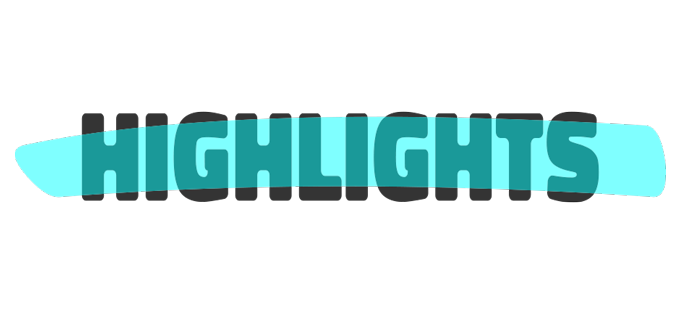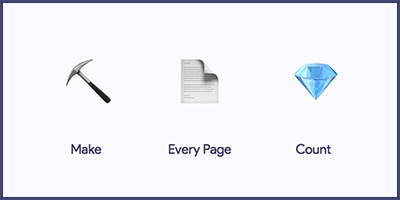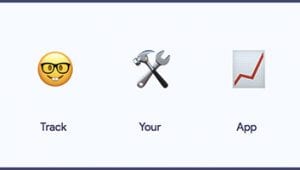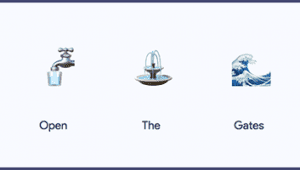Anatomy of a Successful Landing Page: What to Optimize And When
⛏
Make
?
Every Page
?
Count
Great. You’ve setup your Website and analytics, and you’re starting to get leads and sales from your traffic. Is your site perfect?
Websites are never perfect. To get exceptional results and performance from your Website, you need to be constantly refining your funnels and create successful landing pages.
A landing page is any entry page on your site. It can be your homepage, a blog post, your contact page, or any other page by which your visitors enter.
This means that your site has both:
- Traditional landing pages: Pages like your home page, or a converting landing page you use for ad or email traffic; the pages that were designed to act as landing pages.
- Unintended landing pages: Pages that by way of sticky content or strong search positioning became landing pages. Those pages can be amplified to get even more results from your site (and you can find those using Highlights).
To get strong results from your landing pages, you need to know the goal of each of your pages.
- Are you trying to get email addresses?
- Are you trying to qualify visitors?
- Are you trying to close sales?
Every page needs a purpose. – Seth Godin, Author & Entrepreneur
Once you’ve established baseline performances for your landing pages, you can start to improve their performances by running weekly or monthly A/B tests.
To help marketers know exactly what to optimize when it comes to landing pages, we created the following guide:
When to Optimize Site Setup
You can’t get sales if your store isn’t open…
As consumers, we’ve come to expect a certain level of responsiveness and availability from Websites. If your site isn’t available, or if it doesn’t respond properly, your clever sales copy won’t save the day. As with emails, the first thing you need to take care of is to make sure that your landing pages are available.
What to Optimize – Site Setup
- Page Speed: People are increasingly impatient with technology. You might lose your visitors if your site does not load within the first 2 or 3 seconds. You can use PageSpeed Insights to benchmark your site’s performance and optimize page speed. You’ll want to look at the page size, the image size, the number of page requests sent, and the landing page elements that get cached by the browser.
- Mobile-Ready: For the first time in 2016, mobile browsing exceeded desktop use. Now, a majority of visitors expect your landing pages to be optimized for mobile (Accelerated Mobile Pages (AMP) will make this even more important). Make sure your Website displays well on mobile to avoid losing visitors and creating frustration.
- Trust Drivers: Your Website needs to inspire trust in order to retain visitors. We’ve all had bad surprises landing on Websites with shady URLs, or sites asking to submit information or payments without proper SSL Encryption (think http://… vs https://…). For $15 to 20 per year, and the price of a good .com URL, you can avoid these problems completely.
- Share-ability (Optional): If you expect visitors to share your site or pages, adding a few Open Graph tags will make sure that the associated posts display the proper descriptions and images on Twitter, Facebook and Pinterest. You can test your pages with the Facebook, Twitter or Pinterest debuggers.
When to Optimize Body Copy
Once you know that potential leads and buyers are not getting repelled by your site, you can turn your attention to the core content of your landing pages.
Depending on your ask (email address, product conversion, etc) and the quality of your traffic, you can aim for conversion rates as high as 20 to 30%.
We’ll cover different ways to assess the quality of your traffic in a future post, but right now, if you’re not getting a 1 to 2% conversion rate, it’s a good idea to start optimizing your landing page’s body copy.
What to Optimize – Body Copy
When you write a blog post, a landing page, or an email, make your customer or prospects the hero. Your job is to give them a plan and guide them to success. – Justin Jackson, Transistor.fm Co-Founder
- The Offer: One of the core rules of landing page optimization is that the page content needs to match the purpose of visit. In other words, you need to create a consistent experience from your ads or emails all the way to the landing page and conversion funnels. If your offer (or the experience) is inconsistent, or if the page contains multiple offers, the conversion rate will drop. Understand where your traffic comes from, and match the value proposition with what they’re looking for.
- The Main Headline: The page’s tagline needs to be clear and concise. Make sure it contains the appropriate keywords. You can test different keyword combinations, lengths or stylings to attract attention. User tests or tools like the Five Second Test will help you understand your visitors’ initial reactions and understandings.
- The Pull: The pull is the first paragraph of your page copy. It’s typically best to locate it near the tagline. It should include the main benefits (not the features). You can experiment by emphasizing different benefits to keep visitors on the page.
- The Image / The Video: Supporting images (or videos) help create an emotional response from visitors. Test different images, videos or screenshots trying to relate with the specific segment or user demographic. Video sometimes helps improve conversion, but it’s more difficult to produce. You can use heatmap tools like Hotjar or Crazy Egg to identify the main elements that attract the attention of your visitors.
- The Social Proof: Photos of customers, testimonies, logos and social media comments can all help drive conversion. Try different messages that relate to your page’s messaging, and try different positionings on the page.
- Trust Drivers: Beyond a good URLs and SSL encryption, trust icons (PayPal, VeriSign Trusted, etc), phone numbers, live chat, warranties, frequently asked questions (FAQs) and clearly visible privacy policies can also help improve your conversion rate. Your visitors are looking for reassurance that they’re dealing with a legitimate organization with proper customer support. Add trust drivers progressively and evaluate their impact on conversion.
- The Layout: A clean page layout, with a streamlined structure (see below?) will help improve your conversion rate. Eliminate unneeded page elements (Landing page design is a reductive process!) and experiment with the page flow (long-form versus short-form). Try to use bullet points or turn the copy into a story.
- The Call to Action (CTA button): There’s been a lot testing done around CTAs. Although buttons and links impact conversion, getting more clicks from the wrong visitors is not really relevant. If your visitors are spending time on your page, and reading your content without clicking, you can experiment with larger call-to-actions, text links, different button colors (complementary or contrasting, positive or negative) or with button repetition (e.g. one button per screen).
- The Supporting Copy: Different types of visitors will consume your landing page copy at different speed. They’ll also make decisions in different ways. Experiment with your sales pitch, try different proofs of benefits (case studies, quantification of benefits, etc), and lower the reading level of your copy. You can use the Flesch–Kincaid readability tests to evaluate the effort required to read your copy.

When to Optimize the Form
If you’re capturing emails or contact information on the page, you’ll want to keep track of your in-form conversion rate (e.g. visitors that start to enter information > form submission). If more than half of the visitors start to enter information, but don’t complete it, your form might be putting people off. Keep track of that conversion rate and optimize.
What to Optimize – Form
- Form Length: Experiment with the number of form fields, or with Facebook, Twitter or Google signup to increase your conversion rate. Don’t ask for information you don’t really need. With the new General Data Protection Regulation (GDPR), your visitors will probably be less and less inclined to want to submit personal information on sign up.
- Form Type: You can experiment with inline (on the page) versus popup forms, and track form completion with Google Analytics. It can be effective to capture the email address upon entry to reengage visitors if they don’t complete the form.
- Field Labels: For forms, especially lengthy forms, field label experiments can provide good results. In a long-standing research using eye-tracking devices, CX Partners demonstrated that certain form formats were more effective than others. Try positioning field labels above the field, testing bold field labels, or making the labels even more scannable, etc.
- Button: The form button is usually an after-thought once the information has been entered. Again, testing different colours, shapes or labels can have a slight impact on conversion.
When to Optimize Page Structure
If a specific landing page conversion is really key to your Website, you can decide to go a step beyond and optimize the page structure using conversion-focused page templates designed specifically to drive conversions. By optimizing the copy and your forms, you’ll already have good results. If you have enough traffic and the gains are worth the investment, you can start experimenting with the page structure.
What to Optimize – Page Structure
Dividing your landing pages into “pages” (or sections) gives readers an easy excuse to stop reading. Stop that. – Amy Hoy, Serial Entrepreneur
- First Screen: This will come naturally from previous recommendations, but you need to optimize the first screen of your landing page. The section lovingly referred to ‘Above the fold’, is the part of your site that is visible without scrolling (about 768 pixels on Desktop). Your visitors might only spend a few seconds on your page, so you want to quickly focus their attention. Have one clear goal, and experiment with your tagline, images and CTAs.
- Navigation: A lot of funnels and conversion flows have minimal or limited site navigations. Consider removing your site navigation on pure landing pages, and limiting the number of outbound links on these pages. Good page titles (the title tag) can help your visitors understand where the page sits within your site structure.
- Page Length: If your page is able to sustain your visitors’ attention, length shouldn’t be much of an issue. If your page is short, but does not perform, try a longer more story-based format. If your page is long, and visitors don’t scroll, try and make the pitch even more concise.
What Makes a Successful Landing Page
Once you’re getting sign ups, leads or conversions, make sure you follow-through with a good Welcome email and onboarding series.
You can use Google Analytics or Highlights to evaluate the effectiveness of your landing pages. Unbounce also has a free Landing Page Analyzer (they also make a landing page builder) that can give you high-level recommendations and help you create a successful landing page.
We covered ways to drive traffic to your landing pages in another post. Sign up to our newsletter to make sure you don’t miss anything.





Trackbacks & Pingbacks
[…] challenge with optimizing web or landing pages is that you need to get a certain amount of traffic in order to iterate fast and reach statistical […]
[…] knew we’d have to do a lot of landing page optimization, and thought we could benefit from their heatmaps and qualitative research tools. We decided to set […]
Leave a Reply
Want to join the discussion?Feel free to contribute!